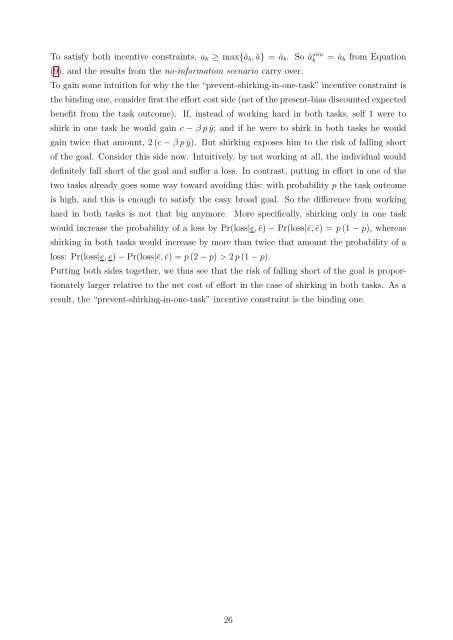Motivational Goal Bracketing - School of Economics and ...
Motivational Goal Bracketing - School of Economics and ...
Motivational Goal Bracketing - School of Economics and ...
You also want an ePaper? Increase the reach of your titles
YUMPU automatically turns print PDFs into web optimized ePapers that Google loves.
To satisfy both incentive constraints, ab ≥ max{âb, ă} = âb. So âsim b<br />
(9), <strong>and</strong> the results from the no-information scenario carry over.<br />
= âb from Equation<br />
To gain some intuition for why the the “prevent-shirking-in-one-task” incentive constraint is<br />
the binding one, consider first the effort cost side (net <strong>of</strong> the present-bias discounted expected<br />
benefit from the task outcome). If, instead <strong>of</strong> working hard in both tasks, self 1 were to<br />
shirk in one task he would gain c − β p ¯y; <strong>and</strong> if he were to shirk in both tasks he would<br />
gain twice that amount, 2 (c − β p ¯y). But shirking exposes him to the risk <strong>of</strong> falling short<br />
<strong>of</strong> the goal. Consider this side now. Intuitively, by not working at all, the individual would<br />
definitely fall short <strong>of</strong> the goal <strong>and</strong> suffer a loss. In contrast, putting in effort in one <strong>of</strong> the<br />
two tasks already goes some way toward avoiding this: with probability p the task outcome<br />
is high, <strong>and</strong> this is enough to satisfy the easy broad goal. So the difference from working<br />
hard in both tasks is not that big anymore. More specifically, shirking only in one task<br />
would increase the probability <strong>of</strong> a loss by Pr(loss|e, ē) − Pr(loss|ē, ē) = p (1 − p), whereas<br />
shirking in both tasks would increase by more than twice that amount the probability <strong>of</strong> a<br />
loss: Pr(loss|e, e) − Pr(loss|ē, ē) = p (2 − p) > 2 p (1 − p).<br />
Putting both sides together, we thus see that the risk <strong>of</strong> falling short <strong>of</strong> the goal is propor-<br />
tionately larger relative to the net cost <strong>of</strong> effort in the case <strong>of</strong> shirking in both tasks. As a<br />
result, the “prevent-shirking-in-one-task” incentive constraint is the binding one.<br />
26
















